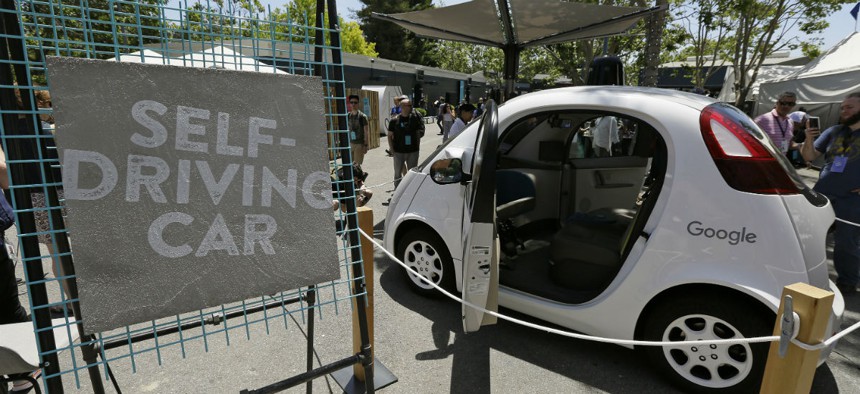With Self-Driving Cars, the Future is Now

A Google self-driving car is seen on display at Google's I/O conference in Mountain View, Calif. Eric Risberg/AP
Much of what was considered the stuff of science fiction is today certainly within reach technologically.
Shawn DuBravac is chief economist of the Consumer Technology Association and the author of "Digital Destiny: How the New Age of Data Will Transform the Way We Live, Work, and Communicate." Follow him on Twitter @shawndubravac.
In the late 1960s, CBS news anchor Walter Cronkite hosted a weekly TV series that predicted what life might be like 30-plus years in the future. "The 21st Century" featured interviews with scientists, researchers and engineers working on the cutting edge of technology.
A half century later, as we saw at the 50th anniversary of CES, the global stage for innovation, much of what was considered the stuff of science fiction—futuristic, even beyond belief—is today, if not taken for granted, then certainly within reach technologically, especially when it comes to today’s transportation transformation.
» Get the best federal technology news and ideas delivered right to your inbox. Sign up here.
Consider the following example from "The 21st Century."
"Autos, Autos Everywhere” was a 1967 look at the cars of the future. Cronkite tests potential concepts like steering controls, screens that give the driver a view behind the car, and an automated route control system that could provide the driver with speed limit and location information.
Cronkite also tests the StaRRcar, a futuristic transportation system that could drive on conventional roads or be locked into an automated track system for high-speed trips over longer distances. In this futuristic setting, the driver could relinquish control and spend time reading, sleeping or watching TV.
These early glimpses of the future offered a first look at driver-assist technology standard on most newer-model cars today and, ultimately, serve as the building blocks for the realization of self-driving cars on open roads. They also illustrate the transformative nature of self-driving cars to forever change society, our culture and how we live our lives.
Last week in Las Vegas, nine automakers and nearly 140 auto tech companies were demonstrating the latest advancements in highly automated cars, including self-driving vehicles and connected driving. As auto manufacturers and aftermarket suppliers increasingly provide an array of automated features, such as parking assist, collision avoidance and emergency braking, and showcase their progress toward driverless cars, fully autonomous roadways are finally within our reach, 50 years after "The 21st Century" showed us what could be.
Cronkite experienced technologies as they might one day appear. But self-driving vehicles aren’t some theoretical idea. In fact, they’re already being tested in California, Nevada, Michigan and Pennsylvania. We aren’t talking about fictitious mirages of what tech might do. We are talking about what innovation has done and what technology is now doing. Self-driving vehicles are among us and they are learning to operate within the real world in which we live.
Driver-assist and self-driving innovations are changing our lives for the better. More than 35,000 people died in crashes on U.S. roadways in 2015 alone, and 2.4 million more were injured. Over 90 percent of those crashes were caused by human error. Self-driving technology holds the potential of preventing much of that carnage.
But the great promise of self-driving vehicles don’t stop with saving lives. This innovation will also transform our lives. Self-driving cars will provide new mobility to millions of elderly and people with disabilities who today have few, if any, options for mobility. They’ll change how we get around and, as a result, what we do. They’ll change how we interact with our children and our families. They’ll change the choices we make on a daily basis—from how we commute to what we do for work.
The reality of self-driving vehicles is just around the corner. And in some corners of the world, this future is coming to fruition with real tests in real communities among real people. At the dizzying rate of technological advances we’re experiencing today, our shared future could well arrive on this side of the 22nd century.
NEXT STORY: Priorities for Enhancing National Cybersecurity



 By
By